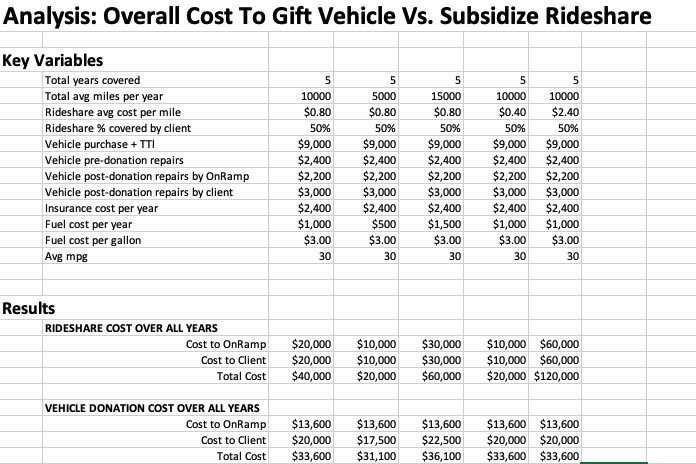What does the future hold for automotive charities like OnRamp? I’ve spent a few days researching that question and crunching numbers, and the results may surprise you. We may be a charitable fleet of robotaxis in the not too distant future! Let me explain.
In the chart below, you’ll see a comparison of total costs over five years for two main options OnRamp may have in the future: continuing to gift a vehicle to a client vs. subsidizing a rideshare program such as Uber or Lyft. The costs for donations and repairs all reflect current 2024 numbers in our charitable program, through 212 vehicles donated so far.
Not surprisingly, the winner completely depends on client miles per year and cost per mile in the rideshare option because in that option, total price is 1:1 (highly) dependent on those two variables. Current national rideshare average cost is $2.40 per mile with Uber and Lyft, and BCS is a bit higher because trips are short and supply of rideshare vehicles is low. I calculated an average of $3 per mile over a set of sample Bryan/College Station trips. At that price, the rideshare option is a non-starter, costing multiple times our current program costs to donate and support vehicles. Note that the costs are totaled for five years rather than one year since our plan has always been to give 5 years of reliable transportation to our clients. Typically the donated car is used up and worth next to nothing at the end of that time, which is why I have not included it as an asset to sell at the end of five years.
But here's where it gets interesting. Tesla has stated that their autonomous taxi will cost $.30-40 per mile as a rideshare fleet vehicle. That's staggeringly low, even beating public transport per mile. For some safety margin, let's double that cost to $.80 per mile. The rideshare option actually becomes quite compelling for clients needing less than 10k miles per year. If Tesla actually succeeds at hitting $.40 per mile, I don’t see us ever giving a vehicle away again except in special circumstances such as very large families, work trucks, or wheelchair vehicles. To service most clients, we would simply provide free or subsidized rides through a fleet of autonomous robotaxis that we either own or lease.
So what do you think? Where am I off? What options or critiques would you add to the conversation?
And on that note, does anyone know anyone at Tesla who would want to discuss this? A partnership between Tesla and an automotive charity like OnRamp could help thousands of struggling individuals and families access essential transportation, and could create significant positive publicity for Tesla. There’s a real win-win opportunity here if we can ever get a foot in the door!




